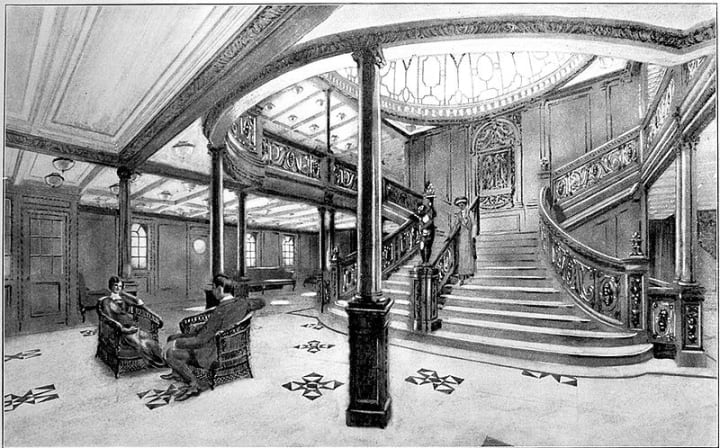
The sinking of the RMS Titanic in April 1912 is the worst in history, and the most infamous cruise shipwreck. More than 1,500 of the 2,208 people aboard the largest passenger plane of the time sank humanity will never forget this accident .

1. The people on the tie tank died before he left.
During the 26-month construction of the Titanic at Belfast's Harland & Wolf Shipyard, 28 serious accidents and 218 minor accidents were recorded. 8 workers were killed.

That was less than expected at the time, which was a death toll for every £ 100,000 spent. As the construction of the Titanic cost 1.5 million pounds, 15 deaths could be estimated. Most of the 8 deaths were due to injuries either from falling off the plane or nearby.
James Dobbins, a 43-year-old sailor, was killed on the day the Titanic was launched. At 12:10 on May 31, 1911, an estimated 10,000 people were seen slipping from the courtyard of a large ship onto the Lagoon River. The sinking was crushed while removing pieces of wood that held the ship straight.
2. The world's largest liner
At its inception, the Titanic became the largest moving man-made object. It was 269 meters long and 28 meters wide. From the nail to the bridge it was 32 meters high, 53 meters to the top of the mound.
Due to its splendor, it was felt that the tie tank should have four exhaust stacks. Thomas Andrews' effective original design, however, required only three. So there was a purely decorative pile on the ship.
The Titanic's unique size is the result of competition between its owners on the White Star Line and the Conard Line.
3. One of the three
Due to its size and the new equipment required, it would have been very expensive to build the Titanic alone. Instead, it was built with two sisters' ships, both of which lasted a lifetime.
Construction of the RMS Olympics first began, and the ship was launched on September 20, 1910. For the next twelve months, the small Olympic was partly the world's largest liner.

At the Olympics, little attention was paid to the details applied to the aesthetics of the Titanic. However, after the former sinking, improvements included the installation of lifeboats for all and in October 1912, the installation of a water tight inner skin.
The Olympics rescued troops from the sinking British warship Adacious in October 1914 and served as a military ship carrying Canadian troops to the European front.
She was the only one of the three to survive more than half a decade. The third and largest ship, the Britannic, went into production after a tie-tank accident and sank in 1916 after colliding with a mine. He was aboard a British hospital.
4. Room for one more (thousand)
When the Titanic sank in 1912, it had about 2,200 people on board, but its maximum capacity was about 3,500. Of these, 1,000 will be staff. In 1912 there were 908 crew members but fewer passengers. There were 324 in first class, 284 in second and 709 in third.
Between 1,490 and 1,635 of them, including the captain, died in the sinking.
5. The total wealth of first class passengers was estimated at $ 500 million.

Of this, $87 million is attributed to John Jacob Easter IV.
On their trip from New York in January 1912, Aster and his wife Madeleine traveled to the Olympics. Astor was the richest passenger on the Titanic on the return journey, and one of the richest people in the world. He drowned because the "women and children first" protocol was usually followed.
An estimated $6 million worth of goods fell on the titanic.
However, Alfred Norney's perceived wealth was not included. Traveling under the false title of Baron Alfred von Drechstedt, Norney used his supposed elite status to transfer to first class.
As soon as the plane sank, he immediately gained access to the lifeboat from his first-class smoking room, unlike the 168 men in his original second-class quarters, of whom only 14 survived the sinking.
6. In first class, the Titanic was a place of luxury.
The liner had four restaurants and passengers ate 50,000 pieces of bone china crockery provided by Liverpool's Estonian & Company.

On board was a reading room, 2 libraries, 2 barber shops and a photography dark room. A heated swimming pool was reserved for first class passengers, 1 shilling at a time. There were also Turkish baths and electric baths, for 4 shillings each at a time.
The Titanic had its own Atlantic Daily bulletin board, which included news, social gossip and the menu of the day.
A first-class passenger will pay £30 for a regular room, or £875 for a parlor suite. However, most passengers were in third class, paying between £ 3 and £8.
There were only two bathrooms for all third-class passengers, most of which were banked in a 164-bed hostel on deck.
7. Titanic was officially responsible for delivering mail to the British Postal Service.
Dex F & G had 5 mail clerks, a post office and a mail room, along with 3,423 sacks of mail. It was reported that during the 2 hours and 40 minutes when the ship sank, the clerks preferred to move the postal sacks to the upper deck.
8. Lifeboat drill scheduled for April 14 was canceled.
This was probably because Captain Edward Smith wanted to provide last Sunday service before retirement. The plane sank that night. The crew drilled only one lifeboat when the plane sank.
Even if the crew had been better trained and each lifeboat had been filled, there would have been only enough space for about a third of the ship's maximum capacity. It was thought the plane would not sink, so it would be time to unload passengers.
This monitoring was made possible by the Merchant Shipping Act of 1894, which was not updated to accommodate ships over 10,000 tons.

9. Debris was discovered in the last 50 years.
The wreckage of the Titanic is 3,700 meters below the surface of the Atlantic Ocean. It was not discovered until 1985, when it was confirmed that the boat had split in two.

The search for the Titanic involved a military operation led by Robert Ballard to survey the remains of some nuclear submarines.
Separate bow and stern are one-third apart. The wreckage covers an area of 15 square miles. Many areas of the ship have not yet been explored, as they are inaccessible to underwater vehicles.
10. The legacy of the Titanic is intact.
The sinking of the Tank has affected many films and documentaries. A request for information on the launch, voyage, sinking and subsequent events of the Titanic was written by Robin and RJ Gibb and presented by the Royal Philharmonic Orchestra.
While the ship itself is fragile enough to be brought to the surface, countless small parts and objects have been saved. Many people, including part of the Hill, stay at the Luxor Hotel in the Las Vegas Strip.
Lesson: Looking back and considering mistakes cannot change what has already happened. What can be changed instead is the things that are happening now and the choices you make today. It is useless to be stuck in the past. Instead, focus on your present and your future.
About the Creator
LeoMorgan
A central question that drives my work is “How can we live better” To answer that question I like to write about science-based ways to solve practical problems☂






Comments
There are no comments for this story
Be the first to respond and start the conversation.